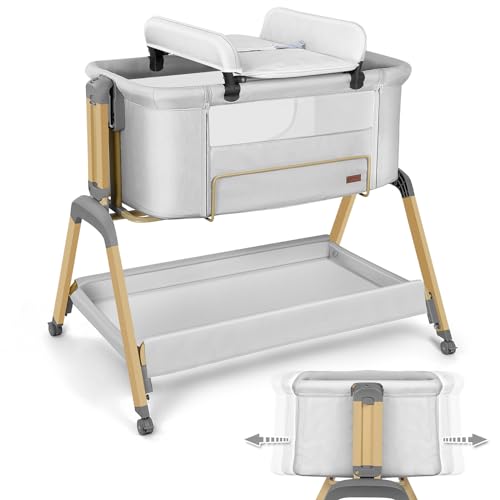What's The Reason Everyone Is Talking About Bedside Co Sleeping Crib Today
The Benefits and Considerations of Bedside Co-Sleeping Cribs
As parents navigate the early months of their child's life, making sure a safe and comfortable sleeping arrangement is typically at the leading edge of their minds. Among the different choices readily available, bedside co-sleeping cribs have gained appeal for their inherent mix of ease of access and safety. This post looks into what bedside co-sleeping cribs are, their benefits, factors to consider for selecting one, and responses to often asked concerns.
What Is a Bedside Co-Sleeping Crib?
A bedside co-sleeping crib is a sleeping space developed to be attached to an adult bed, providing a suitable and safe environment for infants. These cribs frequently feature adjustable heights and safe and secure accessories that allow parents to quickly reach their sleeping baby while also making sure that the baby has their independent sleeping space.
Provided the growing conversation around the advantages and threats of co-sleeping, these specially created cribs aim to strike a balance in between keeping the baby close for comfort and guaranteeing their safety.
Benefits of Bedside Co-Sleeping Cribs
Increased Convenience
- Bedside co-sleeping cribs make it possible for parents to be close to their baby throughout the night. This proximity is especially helpful for breastfeeding moms, who can feed and comfort their child without leaving their bed.
Security Features
- The majority of co-sleeping cribs come geared up with features such as safe accessories, breathable mesh sides, and strong frames. These safety elements assist to avoid accidental suffocation or rolling over onto the baby.
Promotes Bonding
- The nearness of a co-sleeping arrangement may cultivate a more powerful psychological bond in between parent and child, boosting feelings of security and convenience for both celebrations.
Alleviate of Monitoring
- Parents can quickly monitor their infant throughout sleep, causing reduced stress and anxiety and supplying assurance.
Motivates Healthy Sleep Habits
- Research study recommends that co-sleeping can encourage babies to establish self-soothing abilities, causing improved sleep patterns gradually.
Advantages
Details
Increased Convenience
Easy access for feeding and convenience throughout the night
Safety Features
Strong accessories and breathable materials
Promotes Bonding
Nearness improves emotional connection
Relieve of Monitoring
Parents can keep a watchful eye on their baby
Motivates Healthy Sleep Habits
Assists infants find out to self-soothe
Considerations When Choosing a Bedside Co-Sleeping Crib
When choosing a bedside co-sleeping crib, parents need to keep in mind numerous factors:
Safety Standards
- Ensure that the crib satisfies existing security requirements set by regulative bodies. Try to find certifications and safety ratings.
Size and Adjustability
- Consider the size of the crib and whether it can adapt to the height of your bed. An ideal crib should fit comfortably against the adult bed.
Relieve of Use
- Analyze functions such as detachable sides, collapsible frames, and ease of assembly and disassembly.
Material Quality
- Invest in cribs made from non-toxic, high-quality materials that promote toughness and safety for long-lasting use.
Visual Compatibility
- While performance is crucial, it's also necessary that the crib matches the bedroom decor.
Top Bedside Co-Sleeping Cribs in 2023
Crib Model
Functions
Cost Range
Chicco Next2Me
Adjustable height, breathable mesh sides, easy folding
₤ 200 – ₤ 300
Baby Delight Snuggle Nest
Removable side, portable, consists of a nightlight
₤ 150 – ₤ 250
HALO Bassinest
Turns 360 degrees, adjustable, includes relaxing sounds
₤ 250 – ₤ 400
Lully Sleep Nest
Convertible design, removable mattress, eco-friendly products
₤ 180 – ₤ 280
Frequently Asked Questions About Bedside Co-Sleeping Cribs
Q1: At what age is it safe to use a bedside co-sleeping crib?A: Bedside co-sleeping cribs are usually safe for infants from birth up until they can pull themselves up, which is generally around 6 months of age. Constantly seek advice from with your pediatrician for individualized guidance.
Q2: Are bedside co-sleeping cribs much better than standard cribs?A: This can depend upon personal choice and lifestyle. Bedside co-sleeping cribs provide immediate accessibility while preserving a separate sleep space for the infant. Traditional cribs, while also safe, need parents to get up to attend to the baby.
Q3: Can I use bedding in a bedside co-sleeping crib?A: It is generally recommended to keep bedding very little. Bedside Cot For Newborn fitted crib sheet suffices to avoid suffocation dangers. Bonus blankets, pillows, and toys ought to be avoided.
Q4: Do I require to discover unique bedding for a co-sleeping crib?A: Most co-sleeping cribs use basic crib-sized mattresses, so finding bedding needs to not be a challenge. Always validate requirements before purchasing.
Q5: Can a bedside crib prevent SIDS?A: While bedside co-sleeping cribs are created to boost safety, they do not ensure defense versus Sudden Infant Death Syndrome (SIDS). To minimize SIDS dangers, follow safe sleep guidelines: location the baby on their back, make sure a company bed mattress, and prevent sleep on soft surface areas.
Bedside co-sleeping cribs serve as a practical compromise between co-sleeping and guaranteeing an infant's security. They provide unparalleled convenience while maintaining the integrity of independent sleep. Nevertheless, possible buyers must thoroughly consider their alternatives based on security, size, and use requirements. As constantly, parents are encouraged to seek advice from healthcare service providers when making decisions about their child's sleeping arrangements.
In conclusion, a bedside co-sleeping crib might be an important addition to any parenting journey, blending security with proximity to develop a nurturing sleep environment.
